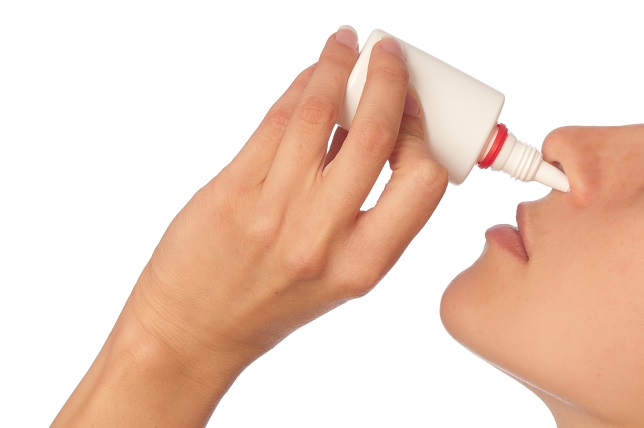
Breakthrough: Nasal spray may soon replace the pill
When the doctor gives us medicine, it is often in the shape of a pill. But when it comes to brain diseases, pills are actually an extremely ineffecient way to deliver drugs to the brain, and according to researchers from University of Southern Denmark we need to find new and more efficient ways of transporting drugs to the brain. Spraying the patient's nose could be one such way.
 Every time we have an infection or a headache and take a pill, we get a lot more drugs than our body actually needs. The reason is that only a fraction of the drugs in a pill reaches the right places in the body; the rest never reaches its destination and may cause unwelcome side effects before they are flushed out of the body again. This kind of major overdosing is especially true when doctors treat brain diseases, because the brain does not easily accept entering drugs.
Every time we have an infection or a headache and take a pill, we get a lot more drugs than our body actually needs. The reason is that only a fraction of the drugs in a pill reaches the right places in the body; the rest never reaches its destination and may cause unwelcome side effects before they are flushed out of the body again. This kind of major overdosing is especially true when doctors treat brain diseases, because the brain does not easily accept entering drugs.
"People with brain diseases are often given huge amounts of unnecessary drugs. During a long life, or if you have a chronic disease, this may become problematic for your health", says Massimiliano Di Cagno, assistant professor at the Department of Physics, Chemistry and Pharmacy, University of Southern Denmark.
He is concerned with finding more efficient ways of delivering drugs to the brain. He and his colleagues at University of Southern Denmark and Aalborg University have turned their attention to the nose - specifically the nasal wall and the slimy mucosa that covers it.
As we know from e.g. cocaine addicts, substances can be assimilated extremely quickly and directly through the nose. But many medical substances, however, need help to be transported through the nasal wall and further on to the relevant places in the brain.
Researchers have long struggled with this challenge and have come up with different kinds of transport vehicles that are very good at transporting the active ingredients through the nasal wall into the brain. The problem with these vehicles, though, is that they cannot release their cargo of drugs once they have reached the inside of the brain. The drugs stay locked inside the strong vehicles.
“If the drugs cannot get out of their vehicles, they are no help to the patient. So we needed to develop a vehicle that does not lock the drug in”, explains Massimiliano Di Cagno.
The vehicles for drug delivery through the nose are typically made of so called polymers. A polymer is a large molecule composed of a large number of repeats of one or more types of atoms or groups of atoms bound to each other. Polymers can be natural or synthetic, simple or complex.
Direct track to the brain
Massimiliano Di Cagno and his colleagues tested a natural sugar polymer and they now report that this particular polymer is not only capable of carrying the drugs through the nasal wall but also – and most importantly – releasing the drug where it is needed.
"This is an important breakthrough, which will bring us closer to delivering brain drugs by nasal spray", says Massimiliano Di Cagno.
With this discovery two out of three major challenges in nasal delivery of brain drugs have been met:
“We have solved the problem of getting the drug through the nose, and we have solved the problem of getting the drug released once it has entered the brain. Now there is a third major challenge left: To secure a steady supply of drugs over a long period. This is especially important if you are a chronic patient and need drug delivery every hour or so”, says Massimiliano Di Cagno.
When a patient sprays a solution with active drugs into his nose cavity, the solution will hit the nasal wall and wander from here through the nasal wall to the relevant places in the brain.
“But gravity also rules inside the nose cavity and therefore the spray solution will start to run down as soon as it has been sprayed up the nose. We need it to cling to the nasal wall for a long time, so we need to invent some kind of glue that will help the solution stick to the nasal wall and not run down and out of the nose within minutes”, says Massimiliano Di Cagno.
The work is a collaboration between Massimiliano Di Cagno, Professor Annette Bauer-Brandl and Associate Professor Judith Kuntsche from the Institute of Physics, Chemistry and Pharmacy at the University of Southern Denmark, and Assistant Professor Thorbjorn Terndrup Nielsen and Associate Professor Kim Lambertsen Larsen from the Department of Chemistry and Environmental Engineering at Aalborg University. The team's work is published in the International Journal of Pharmaceutics.
Ref: β-Cyclodextrin-dextran polymers for the solubilization of poorly soluble drugs, International Journal of Pharmaceutics. Massimiliano di Cagno, Thorbjørn Terndrup Nielsen, Kim Lambertsen Larsen, Judith Kuntsche, Annette Bauer-Brandl.
Photo: Colourbox.
Kontakt
Assistant Professor Massimiliano Di Cagno, Department of Physics, Chemistry and Pharmacy, mdc@sdu.dk. Tel:+45 6550 2504